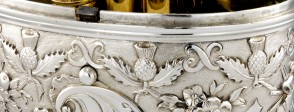Look at the image of the unopened travelling canteen in For the classroom and ask students if they could guess what it is. Gradually reveal more about the object by displaying images of the canteen with its top taken off and then with its contents spread out. Ask students if they think the canteen belonged to a rich or poor person. Explain that condiments such as salt, pepper and nutmeg were very expensive in the 18th century, so the fact that the canteen contains salt-and-pepper shakers and a nutmeg grater, all made in silver, suggests that the person for whom this was made must have been very wealthy. Focus in on the decorative details and see if these mean anything to the students. Explain the significance of the thistle and the Prince of Wales feathers in relation to Charles Edward Stuart.
Teach the narrative of the 1745 Rebellion ending with Culloden. Explain that the canteen was captured on the battlefield and discuss the reasons why the Duke of Cumberland may have given it to one of his aides.
Use the canteen to link to the battle of Culloden and familiarise students with the Duke of Cumberland’s subsequent reprisals. Select a number of individuals with differing views and invite students to produce pieces of writing that demonstrate their responses to the defeat of Rebellion and its aftermath. Possibilities might include: a member of one of the Highland clans, a soldier in Cumberland’s army, a Scottish Presbyterian who had been opposed to the Jacobite cause.
Print out the objects in A bigger picture and ask the students to sort them into pro- and anti-Jacobite groups. Identify how Jacobitism is represented in each group, looking for links across both. Explain to the students that towards the end of the 1700s, the Hanoverians themselves adopted a romanticised Jacobitism. Discuss why they may have done so and what message it was communicating to Scots and to English.
Dr Jacqueline Riding has made a comparison of two portraits of Charles Edward Stuart which could be adapted for the classroom. Show students the image of the shortbread tin from the link in For the classroom. Discuss what this image of Charles suggests in marketing terms about the product, linking it to the rest of the decoration of the tin. Tell them that this is an actual painting of Charles and show them the two portraits in For the classroom: the first by Pettie, which is on the tin, and the second by Blanchet. Discuss the similarities and differences in representation of Charles and ask the students when they think the two portraits were painted. Explain that Blanchet’s is a contemporary portrait of the teenage Charles pre-Rebellion, dressed in the formal, regal tradition and that Pettie’s portrait was created more than a century after Charles’s death and shows him in what was his triumphant hour, shortly after he had captured Edinburgh in 1745 and proclaimed his father king. Discuss why they think the manufacturers of the shortbread chose the Pettie portrait for their marketing. This initial investigation could be developed in to a full enquiry into the representation of Scottish identity from 1745 to the present day.
Where did it go wrong for the Jacobites?
Run the BBC interactive animation on the key events of the 1745 Rebellion in For the classroom. At each stage, ask students whether or not they agree with Charles’s decision and discuss the extent to which each decision contributed to the Jacobites’ eventual defeat. You could create option cards for each stage of the animation and ask students to choose which course of faction they would advise Charles to take.
How Scottish was the British Empire?
Use the commemorative medal in For the classroom to create an initial short investigation into the Darien Scheme. This will help students understand that Scotland as well as England had interests in trade and colonisation. Ask them how they think the failure of the Scheme may have been a factor in Scottish agreement to the Acts of Union of 1707. Once you have established that Union allowed Scottish traders and entrepreneurs to benefit from what was now a British Empire, go on to explore some of the ways in which Scotland participated in the Empire – the Scotland’s history videos in For the classroom cover a number of aspects of this. As the enquiry enters the 1800s, the focus could extend beyond the participation of Scots in the upper levels of empire to explore Scottish settlers in the colonies, driven there by poverty and loss of land. The history of Scottish emigration could be traced through to the twentieth century and the mass emigrations followed World War I.


